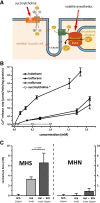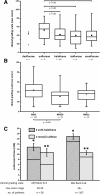Functional and genetic characterization of clinical malignant hyperthermia crises: a multi-centre study
- PMID: 24433488
- PMCID: PMC3896768
- DOI: 10.1186/1750-1172-9-8
Functional and genetic characterization of clinical malignant hyperthermia crises: a multi-centre study
Abstract
Background: Malignant hyperthermia (MH) is a rare pharmacogenetic disorder which is characterized by life-threatening metabolic crises during general anesthesia. Classical triggering substances are volatile anesthetics and succinylcholine (SCh). The molecular basis of MH is excessive release of Ca2+ in skeletal muscle principally by a mutated ryanodine receptor type 1 (RyR1). To identify factors explaining the variable phenotypic presentation and complex pathomechanism, we analyzed proven MH events in terms of clinical course, muscle contracture, genetic factors and pharmocological triggers.
Methods: In a multi-centre study including seven European MH units, patients with a history of a clinical MH episode confirmed by susceptible (MHS) or equivocal (MHE) in vitro contracture tests (IVCT) were investigated. A test result is considered to be MHE if the muscle specimens develop pathological contractures in response to only one of the two test substances, halothane or caffeine. Crises were evaluated using a clinical grading scale (CGS), results of IVCT and genetic screening. The effects of SCh and volatile anesthetics on Ca2+ release from sarcoplasmic reticulum (SR) were studied in vitro.
Results: A total of 200 patients met the inclusion criteria. Two MH crises (1%) were triggered by SCh (1 MHS, 1 MHE), 18% by volatile anesthetics and 81% by a combination of both. Patients were 70% male and 50% were younger than 12 years old. Overall, CGS was in accord with IVCT results. Crises triggered by enflurane had a significantly higher CGS compared to halothane, isoflurane and sevoflurane. Of the 200 patients, 103 carried RyR1 variants, of which 14 were novel. CGS varied depending on the location of the mutation within the RyR1 gene. In contrast to volatile anesthetics, SCh did not evoke Ca2+ release from isolated rat SR vesicles.
Conclusions: An MH event could depend on patient-related risk factors such as male gender, young age and causative RyR1 mutations as well as on the use of drugs lowering the threshold of myoplasmic Ca2+ release. SCh might act as an accelerant by promoting unspecific Ca2+ influx via the sarcolemma and indirect RyR1 activation. Most MH crises develop in response to the combined administration of SCh and volatile anesthetics.
Figures




References
-
- Monnier N, Procaccio V, Stieglitz P, Lunardi J. Malignant-hyperthermia susceptibility is associated with a mutation of the alpha 1-subunit of the human dihydropyridine-sensitive L-type voltage-dependent calcium-channel receptor in skeletal muscle. Am J Hum Genet. 1997;60:1316–1325. doi: 10.1086/515454. - DOI - PMC - PubMed
Publication types
MeSH terms
Substances
LinkOut - more resources
Full Text Sources
Other Literature Sources
Molecular Biology Databases
Research Materials
Miscellaneous

